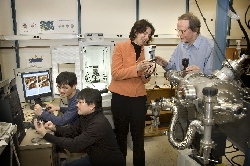
Contact: Karen McNulty Walsh, 631-344-8350, kmcnulty@bnl.gov; Mona S. Rowe, 631-344-5056, mrowe@bnl.gov; both with Media Relations for Brookhaven National Laboratory
Photo: (Clockwise) Brookhaven Lab researchers Kotaro Sasaki, Junliang Zhang, Eli Sutter, and Radoslav Adzic view gold clusters on a single-crystal platinum surface using a scanning tunneling microscope. Hi-res version available.
Platinum is the most efficient electrocatalyst for accelerating chemical reactions in fuel cells. However, in reactions during the stop-and-go driving of a fuel-cell-powered electric car, the platinum dissolves. In accelerated tests, as much as 45 percent of the catalyst can be lost during five days. "Platinum is by far the best single component catalyst for the oxygen reduction reaction, and we have to find a way to protect it," Adzic said. Under lab conditions that imitate the environment of a fuel cell, Adzic and a team of Brookhaven researchers, including Junliang Zhang, Kotaro Sasaki, and Eli Sutter, added gold clusters to a platinum electrocatalyst, which kept it intact during an accelerated stability test that simulates stop-and-go driving in an electric car.
The details: A fuel cell converts hydrogen and oxygen into water and, as part of the process, produces electricity. Hydrogen is oxidized at the device's anode (the terminal where current flows in) when electrons are released and hydrogen ions are formed; the released electrons supply current for an electric motor. These electrons flow to the cathode (the terminal where current flows out) to reduce oxygen, and in a reaction with hydrogen ions, water, the only byproduct of a fuel cell reaction, is produced. Platinum electrocatalysts are used to speed up the oxidation and reduction reactions involved in this process, but as a result, they, too, are oxidized (lose electrons) and dissolve.
In the unique method used at Brookhaven, researchers place gold on carbon-supported platinum nanoparticles by displacing a single layer of copper and subject it to several sweeps of voltage. The copper is needed to reduce the charged gold particles to neutral atoms; it then conveniently forms a monolayer of platinum by an adsorption process, the binding of molecules or particles to a surface. Using x-rays as probes at Brookhaven's National Synchrotron Light Source, a scanning transmission microscope at Brookhaven's Center for Functional Nanomaterials, and electrochemical techniques in the laboratory, the scientists can show that less platinum is oxidized with this method. As predicted, during laboratory testing, the platinum electrocatalyst remains stable when under conditions mimicking stop-and-go driving conditions. Next, researchers will test the catalyst in real fuel cells at the DOE's Los Alamos National Laboratory in
"The very promising properties of fuel cells have been known for many decades," Adzic said. "But it's only now that we can look at the activities and qualities of the catalysts and find something stable enough to be used in cars or residential applications."
This research is funded through the




 Sign Up to Receive Press Releases:
Sign Up to Receive Press Releases: